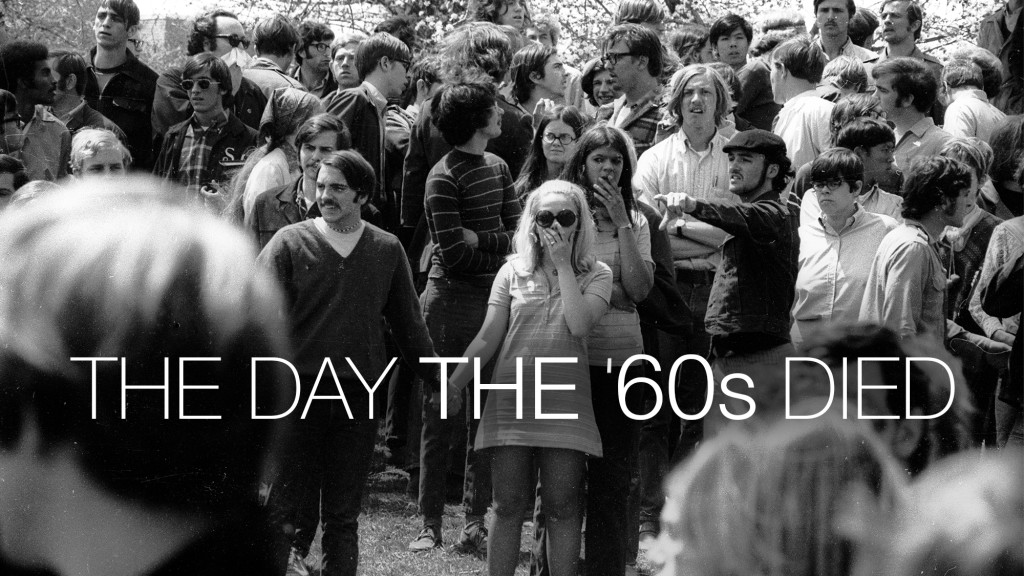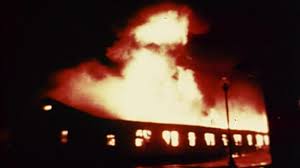PBS Film Commemorates 1970 Kent State Shootings
 (The Day the ’60s Died airs tonight)
(The Day the ’60s Died airs tonight)
Forty-five years ago (on May 4, 1970) America was facing an identity crisis that erupted in the Kent State shootings. During the 1960s, the rise of public television ushered in a medium that could fully orchestrate public consciousness, in concert with the rapid growth of mass higher education. Nightly news hammered home the evils of the Vietnam War, while professors found universities the ideal medium for controlling the minds and futures of impressionable youth. Drugs, sex, and rock music incubated them against societal constraints. Hedonism is more fun than discipline, isn’t it?
The antiwar drumbeat of the 1960s came to a head after the 1968 Tet Offensive, as public and political support for patriotism and the armed forces took a nosedive. “Get out whatever the cost” was the unstated sentiment back home. Too bad for those already in the throes of combat. Troops in the war zone were still a good diplomatic bargaining chip, weren’t they? There was no talk about actually winning the war. During the Korean War, China had taught us to expect no more than a draw. There was no talk of invading North Vietnam or using nuclear weapons.
Nixon could only win the presidency in 1968 by promising to get us out of what was now a lame duck war without commitment. The My Lai massacre of November 1969 revealed what can happen to fighting forces no longer sure about anything involving patriotism and duty. Hatred was coming from people back home even while the military were facing severe deprivations on the battlefield in their defense. Comfortable politicians, professors, and news anchors seemed to be in charge. Ruthless, do-whatever-it-takes tactics in the field were out of the question. Television coverage imposed its own rules-of-engagement logic. Soldiers died. My Lai happened.
Kent State back then was a place where protestors could heap as much verbal and physical abuse on police as they wanted to. The police were told to always be in stand-down mode as beer bottles and rocks were thrown at them and police cars smashed. Wikipedia details how “Trouble exploded in town around midnight, when people left a bar and began throwing beer bottles at police cars and breaking downtown storefronts. In the process they broke a bank window, setting off an alarm. The news spread quickly and it resulted in several bars closing early to avoid trouble. Before long, more people had joined the vandalism.”
Of course, weakness breeds contempt, not respect. The ROTC  Building (photo) was burned to the ground, and the local police lost all control of the ugly crowd. The Governor of Ohio declared a state of emergency, imposed a form of martial law, and called out the National Guard to protect the citizens. The soldiers were surrounded by violence and chaos. They were afraid. Four students were shot dead.
Building (photo) was burned to the ground, and the local police lost all control of the ugly crowd. The Governor of Ohio declared a state of emergency, imposed a form of martial law, and called out the National Guard to protect the citizens. The soldiers were surrounded by violence and chaos. They were afraid. Four students were shot dead.
Pacified by the numbing effects of consumer electronics, teens today may riot and loot during Spring Breaks and after over-hyped sports events, but the media no longer uses them as its conduit for socially programming America. Racial division is even better because only one side gets to frame the discussion. White students out as victims, black thugs in.
Police now must submit to untold verbal and physical assaults, thus putting their own safety at risk just in case the media wants to put them on trial. Businesses are burned and looted, while police stand helplessly by. Not a single person alive can be perfect (nor should they attempt to be) if scrutinized 24/7 by the all-seeing eye of the camera, which is liable to being hopelessly out-of-context much of the time.
Idealistic libertarians still dream of a world based on anarchism, defined by the online dictionary as a belief in “the organization of society on a voluntary, cooperative basis without recourse to force or compulsion.” Yes, perfect when everyone is benign and well-intentioned, but atrocious when evil-doers and sociopaths are running amok.
The ’60s dead? No way. Just look around at all the liberals everywhere in government, education, and media. They literally own our world. Kent State was a tragedy because the students didn’t realize then that they’d already won without the need for further violence.
 (The Day the ’60s Died airs tonight)
(The Day the ’60s Died airs tonight) Building (photo) was burned to the ground, and the local police lost all control of the ugly crowd. The Governor of Ohio declared a state of emergency, imposed a form of martial law, and called out the National Guard to protect the citizens. The soldiers were surrounded by violence and chaos. They were afraid. Four students were shot dead.
Building (photo) was burned to the ground, and the local police lost all control of the ugly crowd. The Governor of Ohio declared a state of emergency, imposed a form of martial law, and called out the National Guard to protect the citizens. The soldiers were surrounded by violence and chaos. They were afraid. Four students were shot dead.